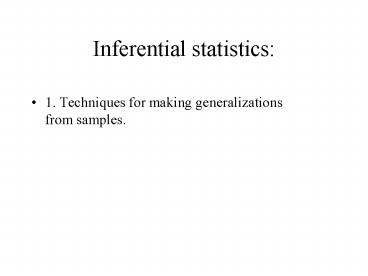Inferential statistics: - PowerPoint PPT Presentation
1 / 10
Title:
Inferential statistics:
Description:
Inferential statistics: 1. Techniques for making generalizations from samples. Hypothesis testing: 1. Determining if the sample is representative enough of the ... – PowerPoint PPT presentation
Number of Views:150
Avg rating:3.0/5.0
Title: Inferential statistics:
1
Inferential statistics
- 1. Techniques for making generalizations from
samples.
2
Hypothesis testing
- 1. Determining if the sample is representative
enough of the population so that an inference can
be made.
3
5-step process for refuting chance (sampling
error)
- 1st. Identify the characteristics of data
collected, I.e., variables
4
2nd State your hypothesis
- (a) research or alternate hypothesis, i.e., the
expected relationship - (b) null hypothesis, i.e., statement of no
relationship, no association, or independence
5
3rd Select sampling distribution
- Use a Z distribution, whenever N is greater than
120 - Use a t distribution whenever N is 120 or less
- 3. Use a one-tail testif the direction of the
difference can be predicted - 4. Use a two-tailed testif direction cannot be
predicted
6
4th calculate test statistic
- Calculate the outcome for your sample, e.g.,
regression, chi-square etc.
7
Level of Significance
- The probability of drawing by chance an unlikely
sample outcome. You can set the alpha at any
level, but the convention is to set at .01 or .05 - 2. Alpha .01 means 1 out of 100
samples(times) you would be wrong to conclude
that the sample differs from the population - 3. Alpha .05, i.e., 5 out 100 samples, etc
8
Critical region
- 1. Rejection region. Once alpha level is
selected, you can determine the sample outcome
that begins the critical region by using the
table--
9
5th make decision on null and research hypotheses
- Decision on Ho
- Reject a null hypothesismeans chance of
an incorrect decision, I.e., type 1 erroris
equal to the alpha level you have selected - accept (fail to reject) means chance of
type 2 error
10
Decision on research on research hypothesis
- 1. Ha is there a statistically significant
difference? - yes no
- reject
- accept
- If you accept then you can conclude that there is
a statistically significant difference - 2. Note you would either conclude that the
sample is or is not representative of the
population from which it was drawn. Implications--































